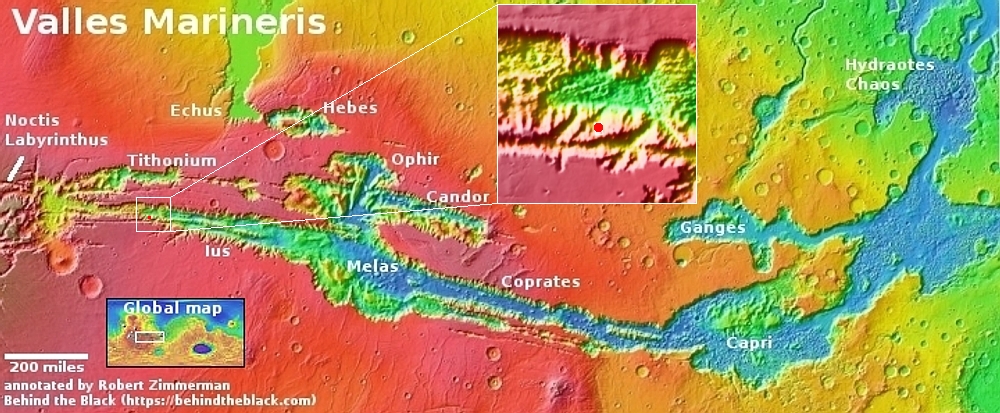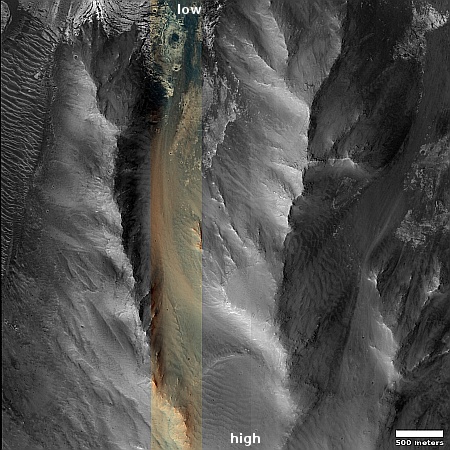A Martian river of sand

Cool image time! The picture to the right, rotated, cropped, reduced, and sharpened to post here, was taken on July 26, 2024 by the high resolution camera on Mars Reconnaissance Orbiter (MRO). The red dot in the overview map above marks the location, within the western reaches of the vast Martian canyon dubbed Valles Marineris.
The picture looks at the flow of dust and sand going down the canyon’s southern rim, with particular focus on the central canyon in the picture’s center. The photo was taken as part of a long-term project, begun in 2020 to monitor this river of sand to see if any changes occur over time. Clearly the sand is flowing downhill, almost like a river, with the dunes almost resembling waves. The geological issue is to determine how fast. Based on the resolution available to me, it is impossible to tell it there have been any changes in the past four years, but the full MRO dataset might reveal more information.
To get an idea of scale, the elevation loss from the top to the bottom in this picture is about 6,000 feet. While this seems like a substantial amount, it pales when placed in the context of Valles Marineris. For example, the elevation loss for the canyon’s northern wall is about 25,400 feet, making that wall exceed in height most of the mountains in the Himalayas. And that wall extends for more than 1,500 miles.
Valles Marineris’ southern wall is more complex. It rises about 18,000 feet from the floor of the canyon to the top of the peak on which this slope sits, but then drops 6,700 feet into a parallel side canyon. From there the rise to the southern rim is about 11,000 feet. All told the southern rim sits about 23,000 feet above the canyon floor, once again a drop that would exceed most mountains on Earth.
On Christmas Eve 1968 three Americans became the first humans to visit another world. What they did to celebrate was unexpected and profound, and will be remembered throughout all human history. Genesis: the Story of Apollo 8, Robert Zimmerman's classic history of humanity's first journey to another world, tells that story, and it is now available as both an ebook and an audiobook, both with a foreword by Valerie Anders and a new introduction by Robert Zimmerman.
The print edition can be purchased at Amazon or from any other book seller. If you want an autographed copy the price is $60 for the hardback and $45 for the paperback, plus $8 shipping for each. Go here for purchasing details. The ebook is available everywhere for $5.99 (before discount) at amazon, or direct from my ebook publisher, ebookit. If you buy it from ebookit you don't support the big tech companies and the author gets a bigger cut much sooner.
The audiobook is also available at all these vendors, and is also free with a 30-day trial membership to Audible.
"Not simply about one mission, [Genesis] is also the history of America's quest for the moon... Zimmerman has done a masterful job of tying disparate events together into a solid account of one of America's greatest human triumphs."--San Antonio Express-News

Cool image time! The picture to the right, rotated, cropped, reduced, and sharpened to post here, was taken on July 26, 2024 by the high resolution camera on Mars Reconnaissance Orbiter (MRO). The red dot in the overview map above marks the location, within the western reaches of the vast Martian canyon dubbed Valles Marineris.
The picture looks at the flow of dust and sand going down the canyon’s southern rim, with particular focus on the central canyon in the picture’s center. The photo was taken as part of a long-term project, begun in 2020 to monitor this river of sand to see if any changes occur over time. Clearly the sand is flowing downhill, almost like a river, with the dunes almost resembling waves. The geological issue is to determine how fast. Based on the resolution available to me, it is impossible to tell it there have been any changes in the past four years, but the full MRO dataset might reveal more information.
To get an idea of scale, the elevation loss from the top to the bottom in this picture is about 6,000 feet. While this seems like a substantial amount, it pales when placed in the context of Valles Marineris. For example, the elevation loss for the canyon’s northern wall is about 25,400 feet, making that wall exceed in height most of the mountains in the Himalayas. And that wall extends for more than 1,500 miles.
Valles Marineris’ southern wall is more complex. It rises about 18,000 feet from the floor of the canyon to the top of the peak on which this slope sits, but then drops 6,700 feet into a parallel side canyon. From there the rise to the southern rim is about 11,000 feet. All told the southern rim sits about 23,000 feet above the canyon floor, once again a drop that would exceed most mountains on Earth.
On Christmas Eve 1968 three Americans became the first humans to visit another world. What they did to celebrate was unexpected and profound, and will be remembered throughout all human history. Genesis: the Story of Apollo 8, Robert Zimmerman's classic history of humanity's first journey to another world, tells that story, and it is now available as both an ebook and an audiobook, both with a foreword by Valerie Anders and a new introduction by Robert Zimmerman.
The print edition can be purchased at Amazon or from any other book seller. If you want an autographed copy the price is $60 for the hardback and $45 for the paperback, plus $8 shipping for each. Go here for purchasing details. The ebook is available everywhere for $5.99 (before discount) at amazon, or direct from my ebook publisher, ebookit. If you buy it from ebookit you don't support the big tech companies and the author gets a bigger cut much sooner.
The audiobook is also available at all these vendors, and is also free with a 30-day trial membership to Audible.
"Not simply about one mission, [Genesis] is also the history of America's quest for the moon... Zimmerman has done a masterful job of tying disparate events together into a solid account of one of America's greatest human triumphs."--San Antonio Express-News


